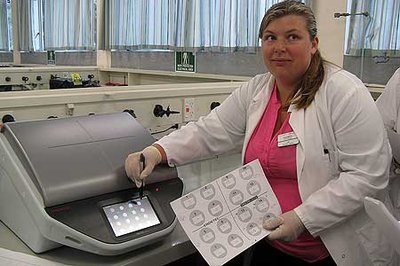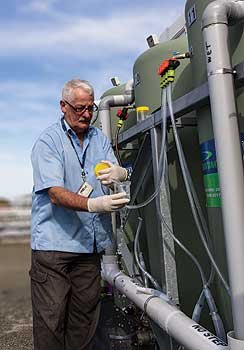
Environmental health students Elizabeth Satherley, William Halkett, Sheetal Prasad (front row) and Nicki Haller, Olivia Hurrel and Kathryn Skinner load the TECTA machine with drinking water samples for E.coli testing.
Students on an Environmental Health Monitoring course at Massey University in Wellington are the first in the country to use a new rapid automated microbiology detection system to monitor water quality.
The student water sleuths used the TECTA B16 system to detect Total coliforms and E.coli in drinking water and river water samples from a range of sites in the Wellington Region.
Stan Abbott, course supervisor and leader of Massey’s Roof Water Harvesting Centre was amazed at how quickly the students familiarised themselves with the sophisticated workings of the TECTA B16 machine.

Environmental health student Elizabeth Satherley retrieves E.coli water sample test results.
“In this digital age our students are all so tech savvy, they understood how to operate the machine with a minimum of fuss, much like them using a new computer or smartphone for the first time,” he says.
Last year’s Havelock North waterborne disease outbreak, in which more than 5,000 people contracted Campylobacter, emphasises the need for fast and accurate water quality monitoring tests. “This new monitoring system is relevant also to the E.coli threshold level, which has been hotly debated around the government’s recent launch of its new Clean Water policy.There has been an endless tide of opinions about the risks that will confront the public when they swim in many of New Zealand’s rivers and lakes, proving that water quality safety for both drinking and swimming in is paramount.”

Stan Abbott from the Roof Water Harvesting Centre in Wellington.
Mr Abbott believes the major advantages of the TECTA B16 automated detection system include:
- A complete, self-contained desktop, touch screen control automated microbiology testing system that is simple to operate and does not require specially qualified personnel.
- Minimal handling of samples and no sample preparation is required. A test can be initiated anytime, while all samples do not have to be loaded into the machine at the same time.
- Full automation of the test analysis and interpretation processes eliminates the need for subjective, visual interpretation of results. An objective, written test report is produced automatically for each sample tested.
Mr Abbott says another huge advantage is that the machine automatically transmits the data through a network connection to allow immediate notification on electronic devices, such as cell phones or laptops, as soon as a contaminated water sample is detected. “Total coliform and E.coli results are available in two to 18 hours, depending on the level of contamination in the water sample. This immediate notification and early warning of positive sample results as soon as they occur should revolutionise water testing,” he says.
The TECTA B16 system received United States Environmental Protection Agency approval in 2014 and the New Zealand Ministry of Health approved the system for testing drinking water samples for compliance in August 2016. Currently three water testing agencies in New Zealand have purchased the system. Mr Abbott expects more will do so in the future given the importance of water quality monitoring in New Zealand.